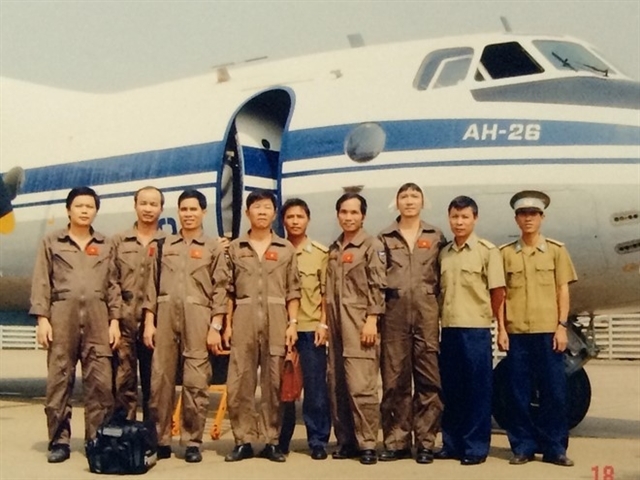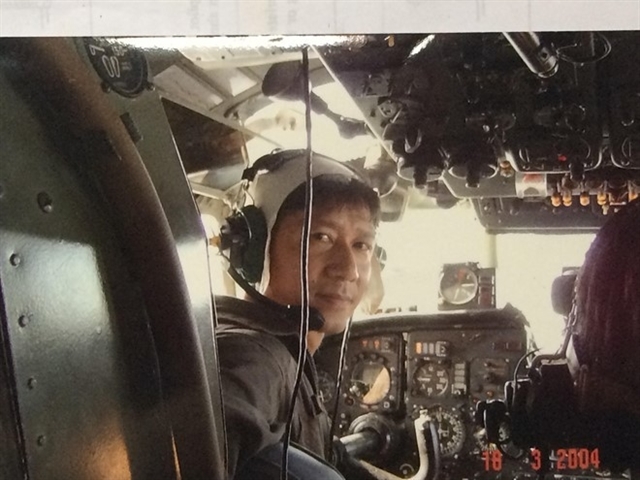 |
|
The Vietnam Air Force’s Brigade 918 in 2004. Photos Courtesy of Nguyễn Anh Sơn
|
Sixty four engineers were killed, 11 wounded and nine kept in prison by the Chinese navy.
Injured soldiers were taken to Sinh Tồn Island (Sin Cowe Island), an island in the Spratly Islands. On March 15, 1988, Colonel Nguyễn Anh Sơn and his flight team under the Vietnam Air Force’s Brigade 918 was tasked with delivering clothes and medicines to the Sinh Tồn Island.
“We have to drop the supplies near the island, not too far so that our soldiers can come and take them,” Sơn said.
The most important thing was not to break the serum bottles, he added.
Sơn, who had been trained as an army pilot in Bulgaria for six years, proposed to his seniors that he would try to drop the supplies at the height of less than 50 metres.
After some serious consideration, the plan was approved. In reality, no pilots in the brigade had ever dropped supplies from such a low position. Safety reasons, of course.
On March 16, five packages of supplies were loaded onto the AN-26, a twin-engined turboprop military transport aircraft, designed and produced in the Soviet Union. From the Cam Ranh Airport, Sơn and his flight crew would have to avoid areas where Chinese navy ships were located if they wanted to be safe.
That would require more fuel.
But since the supplies cargo took much of the space, carrying extra fuel tanks was not an option.
They decided to take the shorter route.
There was no guidance system for AN-26 at the time: once the aircraft was 200km from the coast, they were on their own with no dials to guide the way.
“We knew it was dangerous – we knew it could mean fatal – but our comrades were waiting and we couldn’t look at them in the eyes if we could not deliver,” Sơn said.
The only spot the crew can observe to know they’re near their target is Đá Lớn Reef, which was 50km to the east of Sinh Tồn Island.
Thirty minutes after taking off, which meant they had been quite far, Đá Lớn Reef was no where to be seen.
Sơn said the crew would keep flying for ten more minutes.
It was getting dark and the fuel was limited.
Ten minutes passed. The crew were silent.
Colonel Sơn felt uneasy. He decided one last idea, ordering the crew to turn right.
 |
|
Colonel Nguyễn Anh Sơn pilots a flight in 2004.
|
For many times during his army life, he had never returned without completing his mission. There was one time in Siem Riep where he was informed that the safety zone was only two kilometres, but he still decided to land and bring injured comrades home.
Then the silence on board was broken as one of the crew member shouted out: “There it is!”. Đá Lớn Reef was seen.
Minh, the pilot, decreased the altitude. Then he said: “There’s a battle ship in front of us!”
The ship, as big as a football pitch, was just under the aircraft. Sơn could almost felt the flag on the ship's mast touching the fuselage.
“Keep flying straight, even if they start shooting it would be hard to be shot at this angle,” Sơn said.
Luckily, there was no shooting. They avoided the ship, but missed their chance to drop the supplies at that side of the Sinh Tồn Island. The crew decided to drop the supplies at the north side of the island.
They could see their soldiers running to their direction, the clear blue sea, and the greenish coral under the water. The aircraft continued to decrease its altitude.
“I knew it was dangerous, but I couldn’t risk breaking all the serum bottles that my comrades need to treat the injured. No one forced me to do so, but it’s the order of the heart, the vow of a soldier,’ Sơn said.
“I didn’t look at the altitude signal anymore – I was only looking at the ground,” Sơn said.
Minh, the co-pilot, then told Sơn that the aircraft was lower than a tree’s top.
The packages were released from the plane. Soldiers on the ground either swam or hastily rowed boats out to the water.
Nguyễn Văn Sĩ, a crew member, informed everyone that only one package was broken.
The sun was going down. For the first time in his life, Sơn saw sunset more beautiful than he had ever seen before. VNS
Thu Van
 A group of Vietnamese engineers were sent to build concrete structures on Gạc Ma, Cô Lin and Len Đao (Landsdowne) Reefs on March 14, 1988, but were attacked by six Chinese frigates.
A group of Vietnamese engineers were sent to build concrete structures on Gạc Ma, Cô Lin and Len Đao (Landsdowne) Reefs on March 14, 1988, but were attacked by six Chinese frigates.